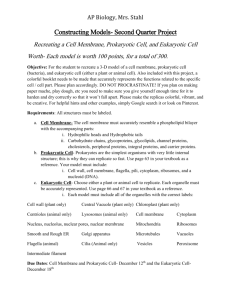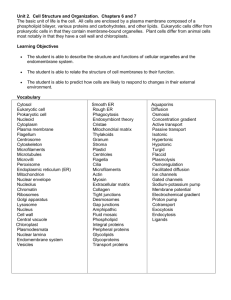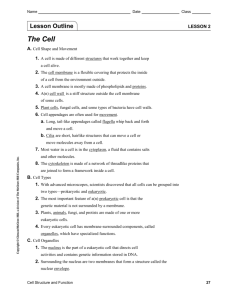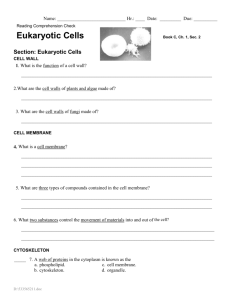biology - Marric.us
advertisement
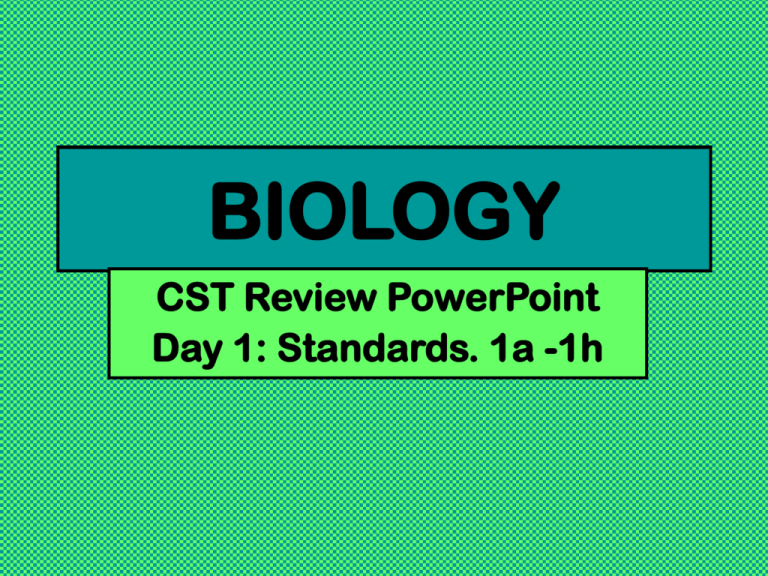
BIOLOGY CST Review PowerPoint Day 1: Standards. 1a -1h According to the Blueprints… a. Students know cells are enclosed within semi-permeable membranes that regulate their interaction with their surroundings. b. Students know enzymes are proteins that catalyze biochemical reactions without altering the reaction equilibrium and the activities of enzymes depend on the temperature, ionic conditions, and the pH of the surroundings. c. Students know how prokaryotic cells, eukaryotic cells (including those from plants and animals), and viruses differ in complexity and general structure. d. Students know the central dogma of molecular biology outlines the flow of information from transcription of ribonucleic acid (RNA) in the nucleus to translation of proteins on ribosomes in the cytoplasm. e. Students know the role of the endoplasmic reticulum and Golgi apparatus in the secretion of proteins. f. Students know usable energy is captured from sunlight by chloroplasts and is stored through the synthesis of sugar from carbon dioxide. g. Students know the role of the mitochondria in making stored chemicalbond energy available to cells by completing the breakdown of glucose to carbon dioxide. h. Students know most macromolecules (polysaccharides, nucleic acids, proteins, lipids) in cells and organisms are synthesized from a small collection of simple precursors. Cells… • A cell is the smallest unit of life that is classified as a living thing, and is often called the building block of life. • Cells can be prokaryotic (bacteria, blue-green algae) or eukaryotic (plants, animals, fungi, protists). • A cell has four basic components: a cell membrane, cytoplasm, and genetic material, and ribosomes. The Cell Membrane • Separates the interior of a cell from the outside environment. • The cell membrane surrounds all cells and is selectivelypermeable, controlling the movement of substances in and out of cells. It is may also be involved in cell signaling and cell adhesion. • It contains a wide variety of biological molecules, primarily proteins and phospholipids. Structure of the Cell Membrane The Fluid Mosaic Model was a model conceived by S.J. Singer and Garth Nicolson in 1972 to describe the structural features of biological membranes. The plasma membrane is described to be fluid because of its hydrophobic integral components such as lipids and membrane proteins that move laterally or sideways throughout the membrane. That means the membrane is not solid, but more like a 'fluid'. The membrane is depicted as mosaic because like a mosaic that is made up of many different parts the plasma membrane is composed of different kinds of macromolecules, such as proteins and glycoproteins. Prokaryotic Cells -have no nucleus, their ‘naked’ DNA is scattered in a region of the cytoplasm. -cytoplasm contains numerous ribosomes but no membrane bound organelles. Bacteria Eukaryotic Cells -have a doublemembraned nucleus, where genetic material is located. -cytoplasm contains a large, complex collection of membrane-bound organelles (ER, vacuoles, mitochondrion, golgi apparatus, chloroplasts) Plants, Animals, Fungi The prokaryotic cell is described to possess ‘naked’ DNA, because the DNA is not associated with any proteins (histones), unlike the genetic material in a eukaryotic cell. Plant Cell Animal Cell -possess a rigid cell wall that contains the fibrous carbohydrate cellulose. -possesses no cell wall. -contains chloroplasts, where photosynthesis takes place. -chloroplasts are absent. -one large central vacuole -one or more small taking up ~90% of the vacuoles. cell’s volume. -Shape is most often rectangular. -Shape is most often round. Which structures are common to both plant and animal cells? Protein Synthesis, Processing, and Modification DNA messenger RNA protein strand • Proteins are manufactured in ribosomes according to the genetic code present in DNA. • Once manufactured, the proteins are shuttled off to the ER (endoplasmic reticulum), an interconnected network of tubules and vesicles, within cells. • From the ER, the proteins are sent to the Golgi Apparatus, which is the site of protein processing and packaging. • The proteins, inside vesicles, then make their way to their destination (e.g. for secretion). Mitochondria • A mitochondrion is a membrane-enclosed organelle found in most eukaryotic cells. • Mitochondria are sometimes described as "cellular power plants" because they generate most of the cell's supply of adenosine triphosphate (ATP), used as a source of chemical energy. In cells, energy from the breakdown of glucose is captured in the bond/s of ATP, for use by cells. Chloroplasts • Chloroplasts are organelles found in plant cells and other protists like algae organisms that conduct photosynthesis. • Chloroplasts capture light energy to conserve energy in the form of ATP and reduce NADP to NADPH through a complex set of processes called photosynthesis. Respiration and Photosynthesis These two processes are complimentary.


